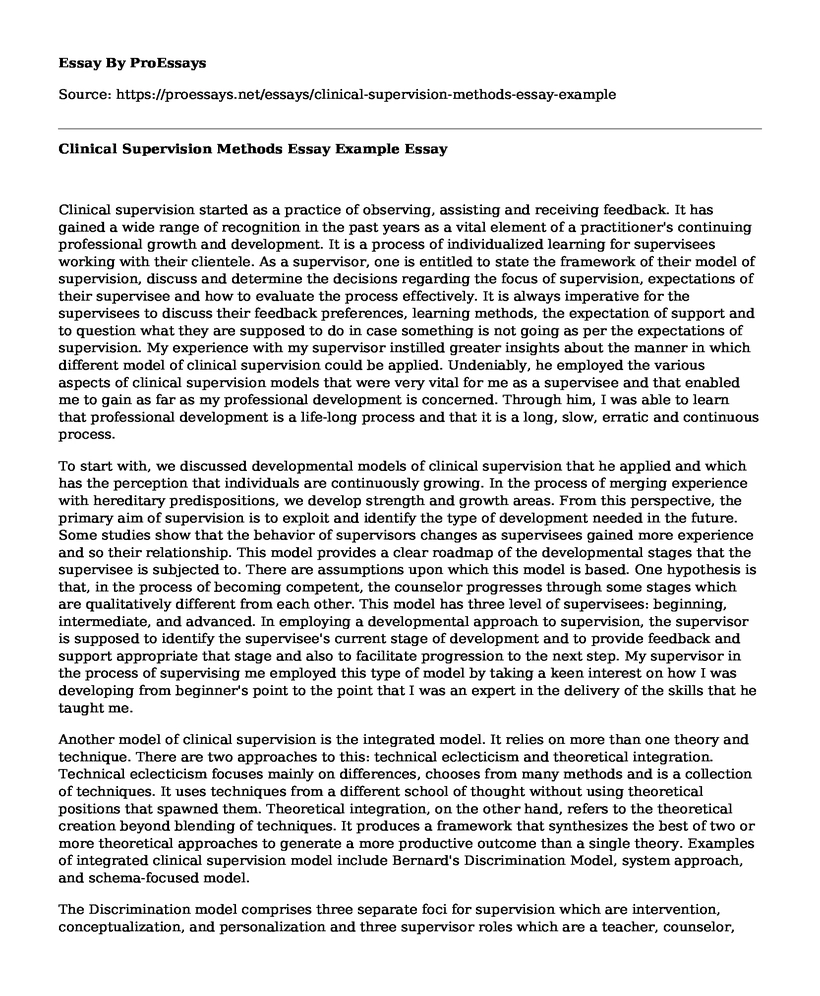Clinical supervision started as a practice of observing, assisting and receiving feedback. It has gained a wide range of recognition in the past years as a vital element of a practitioner's continuing professional growth and development. It is a process of individualized learning for supervisees working with their clientele. As a supervisor, one is entitled to state the framework of their model of supervision, discuss and determine the decisions regarding the focus of supervision, expectations of their supervisee and how to evaluate the process effectively. It is always imperative for the supervisees to discuss their feedback preferences, learning methods, the expectation of support and to question what they are supposed to do in case something is not going as per the expectations of supervision. My experience with my supervisor instilled greater insights about the manner in which different model of clinical supervision could be applied. Undeniably, he employed the various aspects of clinical supervision models that were very vital for me as a supervisee and that enabled me to gain as far as my professional development is concerned. Through him, I was able to learn that professional development is a life-long process and that it is a long, slow, erratic and continuous process.
To start with, we discussed developmental models of clinical supervision that he applied and which has the perception that individuals are continuously growing. In the process of merging experience with hereditary predispositions, we develop strength and growth areas. From this perspective, the primary aim of supervision is to exploit and identify the type of development needed in the future. Some studies show that the behavior of supervisors changes as supervisees gained more experience and so their relationship. This model provides a clear roadmap of the developmental stages that the supervisee is subjected to. There are assumptions upon which this model is based. One hypothesis is that, in the process of becoming competent, the counselor progresses through some stages which are qualitatively different from each other. This model has three level of supervisees: beginning, intermediate, and advanced. In employing a developmental approach to supervision, the supervisor is supposed to identify the supervisee's current stage of development and to provide feedback and support appropriate that stage and also to facilitate progression to the next step. My supervisor in the process of supervising me employed this type of model by taking a keen interest on how I was developing from beginner's point to the point that I was an expert in the delivery of the skills that he taught me.
Another model of clinical supervision is the integrated model. It relies on more than one theory and technique. There are two approaches to this: technical eclecticism and theoretical integration. Technical eclecticism focuses mainly on differences, chooses from many methods and is a collection of techniques. It uses techniques from a different school of thought without using theoretical positions that spawned them. Theoretical integration, on the other hand, refers to the theoretical creation beyond blending of techniques. It produces a framework that synthesizes the best of two or more theoretical approaches to generate a more productive outcome than a single theory. Examples of integrated clinical supervision model include Bernard's Discrimination Model, system approach, and schema-focused model.
The Discrimination model comprises three separate foci for supervision which are intervention, conceptualization, and personalization and three supervisor roles which are a teacher, counselor, and consultant. Supervisors are cautioned not to respond from the same focus but ensure that the center and function meet the most needs of the supervisee at that moment. My supervisor applied this by evaluating my ability within the focus area of clinical supervision and selected a role to respond to which was on how to handle patients.
Conclusion
In the Systems Approach, the heart of supervision is the relationship between the supervisee and the supervisor and is aimed at bestowing power to both parties. The dimensions of supervision here include the functions of supervision, task, the client, the trainee, the supervisor, and the institution. Supervision is as a reflective of a unique combination of the above. As far as my supervisor was concerned, he never employed the system approach as he supervised me. Lastly is the Psychotherapy-Based supervision model which is often a natural extension of therapy. This model follows the framework and techniques of specific psychotherapy model being practiced by the supervisor and the supervisee. Examples include Psychodynamic, Feminist, Cognitive-Behavioral, and Person-Centered.
References
Acheson, K. A., & Gall, M. D. (2003). Clinical supervision and teacher development: Preservice and inservice applications. John Wiley & Sons, Inc., 111 River Street, Hoboken, NJ 07030.
Smith, K. L. (2009). A brief summary of supervision models. An Imprint of Wiley. 10475 Crosspoint Blvd, Indianapolis,
https://www.aipc.net.au/articles/theories-and-models-of-supervision/Smith, K. L. (2009)..
Cite this page
Clinical Supervision Methods Essay Example. (2022, Jun 06). Retrieved from https://proessays.net/essays/clinical-supervision-methods-essay-example
If you are the original author of this essay and no longer wish to have it published on the ProEssays website, please click below to request its removal:
- Personal Essay Example - My Education Goal
- An Incident Management System Questions and Answers Paper Example
- How to Prepare for Hurricane Season Essay
- The Impact of Family Satisfaction on the Perception of Nursing Care Paper Example
- Essay Sample on State Nursing Boards Empowering Competent Practices Across US States
- Research Paper on Learning Disabilities: Discrimination and Inappropriate Care
- Paper Sample on Self-Care: Essential Practice for Attitude & Well-Being







